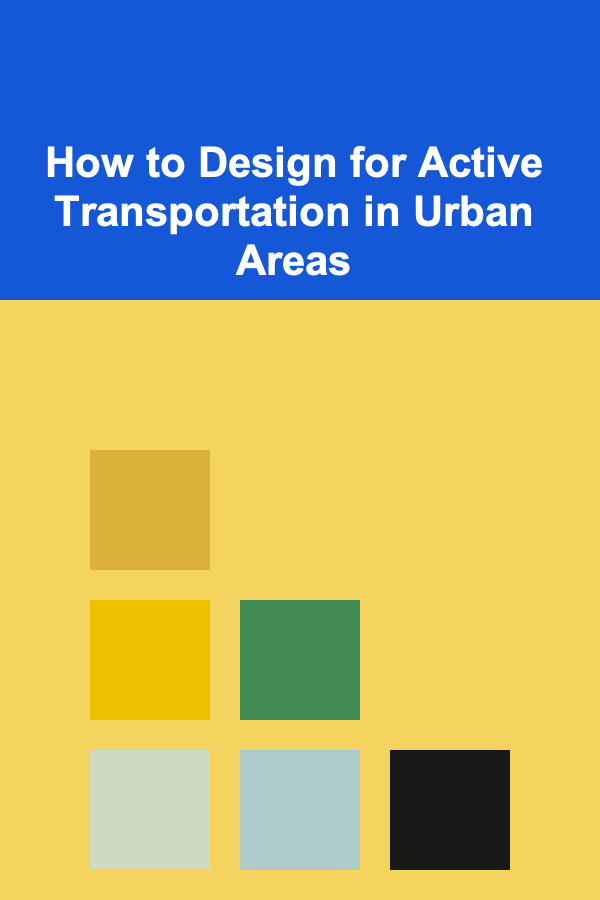
How to Design for Active Transportation in Urban Areas
ebook include PDF & Audio bundle (Micro Guide)
$12.99$10.99
Limited Time Offer! Order within the next:

Active transportation refers to any form of human-powered travel, including walking, cycling, and other non-motorized means of transport. As urban areas continue to grow and face increasing challenges related to traffic congestion, pollution, and public health, the need for effective active transportation infrastructure has become a critical focus for city planners and policymakers. Designing for active transportation not only contributes to environmental sustainability but also fosters healthier, more livable communities.
In this article, we will explore the key principles and strategies for designing urban areas that prioritize active transportation. We will discuss the challenges involved, the benefits of such design, and how cities around the world are taking steps toward more sustainable and inclusive urban planning.
The Importance of Active Transportation
Before delving into the specifics of design, it is essential to understand why active transportation is crucial in modern urban areas. As cities become more densely populated and vehicle-centric, many urban centers struggle with issues like traffic congestion, air pollution, and a decline in public health due to sedentary lifestyles.
Environmental Benefits
One of the most compelling reasons for promoting active transportation is its environmental impact. Pedestrians and cyclists produce zero emissions, unlike cars, which contribute significantly to air pollution and greenhouse gas emissions. Encouraging more walking and cycling reduces the reliance on cars, decreasing traffic congestion and improving air quality.
Health and Well-being
Active transportation promotes physical activity, which is essential for combating lifestyle-related diseases such as obesity, heart disease, and diabetes. Encouraging people to walk or cycle rather than drive not only helps them maintain a healthier lifestyle but also reduces healthcare costs in the long run. Additionally, walking and cycling can have positive mental health benefits, including reducing stress and improving mood.
Reduced Traffic Congestion
In many urban centers, traffic congestion is a major issue. By encouraging active transportation, cities can reduce the number of vehicles on the road, alleviating traffic jams and improving the overall flow of traffic. This, in turn, reduces travel times, making urban areas more efficient and accessible.
Equity and Inclusivity
Active transportation infrastructure can also address social equity. Not everyone can afford a car, and many individuals rely on walking or cycling to get to work, school, or other essential services. By designing cities that prioritize active transportation, we create more inclusive urban spaces that serve people of all income levels and abilities.
Key Design Principles for Active Transportation
Designing for active transportation requires a shift in how we approach urban planning. Traditional city designs prioritize vehicles, with pedestrians and cyclists often relegated to secondary spaces. To create cities that encourage active transportation, we must adopt a more holistic approach that integrates these modes of transport into the overall infrastructure.
1. Safety First
Safety is the foremost consideration when designing for active transportation. Both pedestrians and cyclists are more vulnerable to traffic-related accidents than motorists, and as such, their safety must be prioritized. The following design strategies can enhance safety:
- Protected Bike Lanes: Bike lanes should be physically separated from motor traffic to reduce the risk of accidents. This can be achieved using barriers such as curbs, planters, or bollards.
- Pedestrian-Only Zones: Designating pedestrian-only zones in high-traffic areas, such as city centers or commercial districts, can ensure that pedestrians can move freely without the risk of colliding with vehicles.
- Crosswalks and Signals: Properly designed crosswalks, with clear markings and dedicated traffic signals for pedestrians, help ensure safe crossings. In addition, traffic lights should be timed to allow pedestrians enough time to cross safely.
- Slow Zones: In areas with high pedestrian or cyclist traffic, speed limits for motor vehicles should be reduced to minimize the risk of accidents. These zones are especially important near schools, parks, and residential areas.
2. Connectivity and Integration
One of the key challenges for active transportation is ensuring that networks are well-connected and easily accessible. Cities should aim to integrate various modes of transport, such as walking, cycling, and public transit, into a cohesive network that encourages seamless movement.
- Cycling and Walking Corridors: Designing continuous cycling and walking corridors that connect key destinations such as residential areas, work centers, schools, parks, and public transit stations is crucial. These corridors should avoid unnecessary detours and obstacles.
- Integration with Public Transport: Active transportation should complement public transit systems. For example, bicycle racks on buses and trains, or convenient pedestrian routes to transit stations, ensure that people can easily switch between different modes of transport.
- Universal Access: Infrastructure should be designed to accommodate people with disabilities. This includes ensuring that sidewalks are accessible, ramps are available, and bike lanes are suitable for people with mobility challenges.
3. Traffic Calming Measures
Traffic calming measures are strategies used to slow down traffic and make streets safer for pedestrians and cyclists. These measures encourage drivers to be more aware of their surroundings and reduce the likelihood of accidents.
- Narrowing Streets: By narrowing the width of streets, drivers are naturally encouraged to slow down. This can be achieved through the use of curb extensions or raised medians.
- Speed Bumps and Raised Crosswalks: Speed bumps or raised crosswalks are effective at slowing traffic in areas with high foot or bicycle traffic. These measures force drivers to reduce their speed, making the area safer for pedestrians and cyclists.
- Roundabouts: Roundabouts are an effective alternative to traditional intersections, as they reduce the likelihood of accidents and force drivers to slow down when entering and exiting the intersection.
4. Providing Amenities and Comfort
Designing for active transportation is not only about safety and accessibility but also about creating an environment where people want to walk or cycle. To encourage more active transportation, urban areas need to provide amenities that make walking and cycling comfortable and convenient.
- Bike Parking and Storage: Adequate bike parking is essential to encourage cycling. Secure bike racks should be provided at key destinations such as office buildings, shopping centers, and transit stations. In some cities, bike-sharing programs are also an excellent way to provide more flexible cycling options.
- Rest Areas and Shade: Walking and cycling can be physically demanding, especially during hot weather. Providing rest areas with seating, shade, and water fountains along pedestrian and cycling routes encourages people to use active transportation for longer trips.
- Lighting and Visibility: Proper lighting along sidewalks and bike lanes is essential for safety, especially during evening hours. Well-lit paths increase visibility, reduce the risk of accidents, and make pedestrians and cyclists feel more secure.
5. Encouraging Mixed-Use Development
Active transportation thrives in environments where people can live, work, and play without relying on cars. Mixed-use development, which combines residential, commercial, and recreational spaces, creates more walkable neighborhoods and reduces the need for long commutes.
- Proximity to Amenities: By ensuring that homes, offices, schools, and stores are located close to each other, cities can encourage people to walk or cycle instead of driving. This not only benefits active transportation but also reduces traffic congestion and pollution.
- Walkable Urban Design: Streets should be designed to be pedestrian-friendly, with wide sidewalks, safe crossings, and traffic-calming measures. Mixed-use areas should prioritize pedestrians over cars to create vibrant, people-centered spaces.
Challenges to Designing for Active Transportation
Despite the many benefits, designing for active transportation comes with its own set of challenges. These challenges include:
1. Space Constraints
In many cities, space is limited, and allocating space for bike lanes or wider sidewalks may face resistance from other road users or businesses. Balancing the needs of pedestrians, cyclists, and motorists requires careful planning and sometimes the reallocation of road space.
2. Resistance from Car-Centric Culture
In many urban areas, cars have long been the dominant mode of transportation, and shifting this mindset can be challenging. There may be resistance from drivers, businesses, and even policymakers who are concerned about losing road space or the economic impact of reducing car access.
3. Climate and Weather Conditions
Climate and weather conditions can also impact the use of active transportation. Cities with harsh winters or rainy seasons may need to invest in additional infrastructure, such as sheltered bike racks or heated sidewalks, to make active transportation more viable year-round.
4. Funding and Political Will
Designing for active transportation requires significant investment in infrastructure, and securing funding for these projects can be difficult. Additionally, political will is essential for making long-term changes to urban design and transportation policy.
Global Examples of Active Transportation Design
Several cities around the world have implemented successful active transportation designs. These cities provide excellent models for others to follow.
- Copenhagen, Denmark: Known as one of the most bicycle-friendly cities in the world, Copenhagen has invested heavily in cycling infrastructure, including dedicated bike lanes, bike-sharing programs, and traffic-calming measures. Over 40% of the city's residents commute by bike.
- Amsterdam, Netherlands: Amsterdam's extensive network of cycling paths and bike racks has made it one of the most walkable and bike-friendly cities in the world. The city's commitment to reducing car usage and promoting cycling has led to a high quality of life for its residents.
- Portland, Oregon, USA: Portland has been a pioneer in promoting active transportation in the United States. The city has built an extensive network of bike lanes and pedestrian-friendly streets, and it has also implemented a successful bike-sharing program.
Conclusion
Designing for active transportation is essential for creating sustainable, healthy, and inclusive urban spaces. By prioritizing safety, connectivity, comfort, and mixed-use development, cities can encourage more walking and cycling, reduce traffic congestion, and improve public health. While there are challenges to overcome, the benefits of investing in active transportation infrastructure are clear. As more cities around the world embrace these principles, the future of urban transportation looks brighter, healthier, and more sustainable.
Reading More From Our Other Websites
- [Toy Making Tip 101] Stitch-and-Play: DIY Fabric Animal Toys for Kids
- [Personal Care Tips 101] How to Choose a Sulfate-Free Conditioner for Gentle Care
- [Beachcombing Tip 101] From Sea-Glass to Storytelling: Turning Beach Finds into Art Projects
- [Personal Investment 101] How to Build an Emergency Fund That Works as a Financial Investment
- [Organization Tip 101] How to Store Jewelry and Accessories in the Bathroom
- [Organization Tip 101] What Tips Can Help You Create a Functional Work-from-Home Space?
- [Polymer Clay Modeling Tip 101] Best Approaches to Creating Custom Polymer Clay Stamps for Repeating Patterns
- [Organization Tip 101] How to Restore the Shine and Luster of Your Quartz Countertop
- [Home Budget Decorating 101] How to Make Your Home Look Expensive on a Tight Budget
- [Home Cleaning 101] How to Clean and Maintain Leather Furniture

How to Create a Checklist for Running Social Media Contests and Giveaways
Read More
How to Create Engaging Video Content That Attracts Viewers and Subscribers
Read More
How to Soundproof Your Windows for a Quieter Home
Read More
How to Stage Your Home's Exterior for Curb Appeal
Read More
Performance Excellence: Driving Results Through Strategic Talent Management
Read More
Unlocking the Secrets of Market Research: Tools and Techniques for Success as a Research Analyst
Read MoreOther Products

How to Create a Checklist for Running Social Media Contests and Giveaways
Read More
How to Create Engaging Video Content That Attracts Viewers and Subscribers
Read More
How to Soundproof Your Windows for a Quieter Home
Read More
How to Stage Your Home's Exterior for Curb Appeal
Read More
Performance Excellence: Driving Results Through Strategic Talent Management
Read More